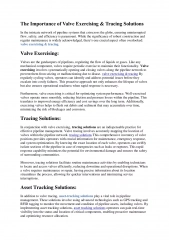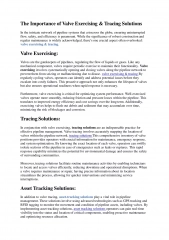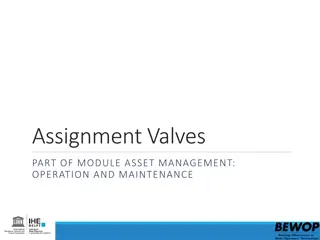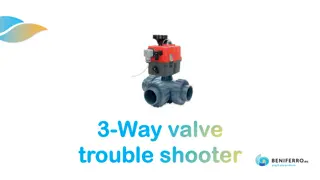
How To Select The Fine Range Of The Valve
Do you need improved performance and quality in your valves that can efficiently improve your production process? If you need top quality valve and valve manufacturing and innovation look no further than CWT Valve. The dedication to doing quality wor
Download Presentation

Please find below an Image/Link to download the presentation.
The content on the website is provided AS IS for your information and personal use only. It may not be sold, licensed, or shared on other websites without obtaining consent from the author. If you encounter any issues during the download, it is possible that the publisher has removed the file from their server.
You are allowed to download the files provided on this website for personal or commercial use, subject to the condition that they are used lawfully. All files are the property of their respective owners.
The content on the website is provided AS IS for your information and personal use only. It may not be sold, licensed, or shared on other websites without obtaining consent from the author.
E N D
Presentation Transcript
How To Select The Fine Range Of The Valve www.cwtvalve.com
If you are thinking How To Select Valve. The decision on which valve to use in a particular application is crucial determinate on the extent of performance, reliability, and the need for durability in fluid control systems. Regardless of whether they confine the flow of fluids, gases or slurry s, valves regulate the flow of these substances. New variations and configurations are selected and the right one can make a big difference in system performance. Here s a complete Valve Selection Guide on how to select a valve: 1. Understand the Application Requirements Before choosing a valve, it s important to understand the precise application needs. Consider the following factors:
Fluid Type:Find whether the valve will control gases, liquids, or slurries. Different materials and designs are essential depending on the nature of the fluid. Pressure and Temperature:The working pressure and the range of the temperature need to be defined. Valve also have a maximum allowable pressure and temperature on them and by choosing a valve that is beyond these parameters the valve will fail. Flow Rate: Assess the required flow rate. This helps in determining the valve size and type. Use flow calculations to understand how much fluid the system needs to move and at what speed. 2. Valve Type Selection Valves come in various types, each designed for specific functions. Here are some common valve types and their applications:
Gate Valves:On/off service capable, gate valves are preferable for purposes which require no restrictions to flow. Instead, they are not suitable for throttling. Globe Valves:Globe valve is used for throttling and flow control services where pressure drop is likely to be high and which require better tolerance control. Ball Valves:Some of the benefits you should know about this ball valves include: very tight shut off, quick acting, are suitable for on/off applications and are used on a variety of fluids. Check Valves:These prevents backflow in a system. They are very important in such uses where backflow is likely to cause harm or pollute the system. Butterfly Valves:Most suitable for flow control, butterfly valves are small in size and therefore ideal for use where pipe sizes are large. Solenoid Valves:Automation of rotary valves with electric commands to regulate control in fluid systems. They are important for those applications which demand quick response times. 3. Material Consideration Choosing the right Valve Material Selection is critical for durability and compatibility with the fluid being controlled. Common materials include:
Stainless Steel:Corrosion free material which can be used in various usages especially in industries such as in manufacture of food processing equipment and medicines. Brass:Well, suited for water, oil and gas services however not suitable for corrosive substances. PVC and CPVC:Preferred for chemical use consistently. Nonetheless, they are light in weight and highly anti- corrosive, but cannot withstand high temperatures. Cast Iron:Which is to be used where the system or its equipment is likely to be exposed to water, or steam. It offers strength in addition to which it has almost low or no resistance to corrosion when compared to stainless steel. Carbon Steel:Suitable for working under high pressure but it needs to be coated or treated to avoid corrosion. 4. Valve Size Selection The size of the valve should match the pipe size in which it is installed. The following factors can help determine the appropriate valve size:
Pipe Diameter:Nominal pipe size (NPS) or outside diameter (OD) should be used in identifying valve size. Valves should seal into the piping system in a non-turbulent way but should fit well into the piping system. Flow Coefficient (Cv):The value determines the volume of the valve for the flow of the fluids in pipeline networks. Thus, Cv value in the range increases proportionally with the flow rate through the valve being higher in this case. By using the required flow rate and pressure drop one will be in a position to determine the Cv required for the certain valve size. 5. Consider Control Mechanisms Depending on the application, you may need manual or automated valve control:
Manual Valves:These are operated by hand wedge type, suitable for the occasions when fine adjustments are not required. Automated Valves:Most suitable for systems where accurate regulation is required and changes are often made. The automation concepts of operation should be electric, pneumatic, and hydraulic actuators. 6. Check for Compliance and Standards Ensure the selected valve fulfils with industry standards and guidelines. Common standards include: API (American Petroleum Institute) ASME (American Society of Mechanical Engineers) ANSI (American National Standards Institute) ISO (International Organization for Standardization) Compliance ensures security, reliability, and interoperability with other system mechanisms.
7. Evaluate Cost and Availability Cost is a important factor in valve selection. While it s important to stay within budget, also consider the long- term costs related with maintenance, replacement, and operative efficiency. Additionally, check the accessibility of the chosen valve type in the market. 8. Assess Manufacturer Reputation Finally, consider the status of the valve manufacturer. Study their track record, customer reviews, and the quality of their products. A trustworthy manufacturer is more likely to provide dependable valves and better customer service. By following these rules, you can ensure that you choose Valve Selection Tool that meets the specific requirements of your fluid control system, eventually leading to better performance, safety, and dependabilit.
CONTACT DETAILS PHONE : +1 403-8006686 EMAIL : info@cwtvalve.com ADDRESS : 5149 Country Hills Blvd NW, Calgary, AB, Canada T3A 5K8 WEBSITE : https://cwtvalve.com/ THANK YOU






















